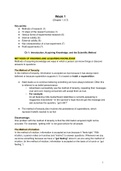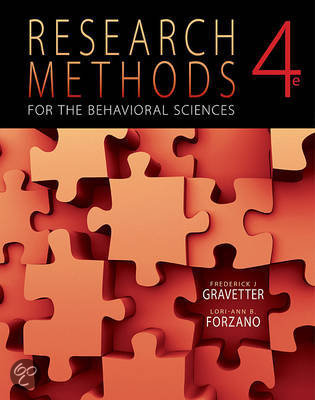Week 1
(Chapter 1, 6,7)
Key points:
● Methods of research (1)
● 10 steps of the research process (1)
● Various forms of experimental research (6)
● Internal validity (6)
● External validity (6)
● Key characteristics of a true experiment (7)
● Field experiments (7)
Ch 1: Introduction, Acquiring Knowledge, and the Scientific Method
METHODS OF KNOWING AND ACQUIRING KNOWLEDGE
Methods of acquiring knowledge are ways in which a person can know things or discover
answers to questions.
The Method of Tenacity
In the method of tenacity, information is accepted as true because it has always been
believed or because superstition supports it. It is based on habit or superstition:
● Habit leads us to continue believing something we have always believed. Often this
is referred to as belief perseverance.
○ Advertisers successfully use the method of tenacity, repeating their messages
over and over, hoping consumers will accept them as true.
○ For example:
An ad featuring milk-mustachioed celebrities is currently appearing in
magazines everywhere—in the sponsor’s hope that we get the message and
ask ourselves the question, “got milk?”
● The method of tenacity also involves the persistence of superstitions, which
represent beliefs reacted to as fact
Disadvantage:
One problem with the method of tenacity is that the information acquired might not be
accurate. For example, “getting milk” is not good advice for all people.
The Method of Intuition
In the method of intuition, information is accepted as true because it “feels right.” With
intuition, a person relies on hunches and “instinct” to answer questions. Whenever we say
we know something because we have a “gut feeling” about it, we are using the method of
intuition. (In the method of intuition, information is accepted on the basis of a hunch or “gut
feeling.”)
1
,For example, intuition provides answers when we are making personal choices between
equally attractive alternatives such as: What should I have for dinner? → choose what you
“feel like” eating
Disadvantage:
The problem with the method of intuition is that it has no mechanism for separating accurate
from inaccurate knowledge.
The Method of Authority
In the method of authority, a person fi nds answers by seeking out an authority on the
subject. This can mean consulting an expert directly or going to a library or a website to read
the works of an expert. Whenever you consult books, people, television, the Internet, or the
newspaper to fi nd answers, you use the method of authority.
The method of faith is a variant of the method of authority in which people have
unquestioning trust in the authority fi gure and, therefore, accept infor mation from the
authority without doubt or challenge. (For instance, young children tend to have absolute
faith in the answers they get from their parents.)
Advantage:
For many questions, the method of authority is an excellent starting point; often, it is the
quickest and easiest way to obtain answers.
Disadvantages:
● It does not always provide accurate information. For example, authorities can be
biased.
● Another limitation of the method of authority is that the answers obtained from an
expert could represent subjective, personal opinion rather than true expert
knowledge.
● An additional limitation of this method is that we assume, by virtue of the person’s
status as an authority, that expertise can be generalized to include the question we
are asking. For example, advertisers often use the endorsements of well known
personalities to sell their products. When a famous athlete appears on television
telling you what soup is more nutritious, should you assume that being an
outstanding football player makes him an expert on nutrition?
● Another pitfall of the method of authority is that people often accept an expert’s
statement without question. As a result, false information is sometimes taken as truth
● As a final pitfall of the method of authority, realize that not all “experts” are experts.
There are a lot of supposed “experts” out there.
The methods of tenacity, intuition, and authority are satisfactory for answering some
questions, especially if you need an answer quickly and there are no serious consequences
for accepting a wrong answer.
However, it should be clear that there are situations for which these uncritical techniques are
not going to be sufficient. In particular, if the question concerns a major fi nancial decision, or
the answer could signifi cantly change your life.
2
,The Rational Method
The rational method, also known as rationalism, involves seeking answers by logical
reasoning. We begin with a set of known facts or assumptions and use logic to reach a
conclusion or get an answer to a question.
For example:
All 3-year-old children are afraid of the dark.
Amy is a 3-year-old girl.
Therefore, Amy is afraid of the dark.
In this argument, the first two sentences are premise statements. That is, they are facts or
assumptions that are known (or assumed) to be true. The final sentence is a logical
conclusion based on the premises. An argument is a set of premise statements that are
logically combined to yield a conclusion.
A common application of the rational method occurs when people try to think through a
problem before they try out different solutions. (Car crashed, but I have an exam, how can I
make it on time?)
In general, a logical conclusion is only valid for the specific situation described by the
premise statements. If the premise statements are incomplete or do not totally represent the
real-world situation, then the conclusion might not be accurate.
Answers obtained using the rational method are not simply accepted as true without
verification. Instead, all conclusions are tested by ensuring that they conform to the rules of
logic. Because the rational method does not involve directly observing or actively gathering
information, it has been said that logic is a way of establishing truth in the absence of
evidence.
The Empirical Method
The empirical method, or empiricism, uses observation or direct sensory experience to
obtain knowledge. Note that when we make observations, we use the senses of seeing,
hearing, tasting, and so on.
Advantages:
In many instances, the empirical method provides an easy, direct way to answer questions.
However, this method of inquiry also has some limitations.
Disadvantages:
● It is fairly common for people to misperceive or misinterpret the world around them.
● Although direct experience seems to be a simple way to obtain answers, your
perceptions can be drastically altered by prior knowledge, expectations, feelings, or
beliefs. As a result, two observers can witness exactly the same event and yet “see”
two completely different things
● Empirical vs. Rational method: Finally, the empirical method is usually time
consuming and sometimes dangerous. When faced with a problem, for example, you
could use the empirical method to try several possible solutions, or you could use the
rational method and simply think about each possibility and how it might work. Often,
3
, it is faster and easier to think through a problem than to jump in with a trial-and-error
approach. Also, it might be safer to use the rational method or the method of
authority rather than experience something for yourself. For example, if I wanted to
determine whether the mushrooms in my back yard are safe or poisonous, I would
rather ask an expert than try the empirical method.
Application:
Summary of Nonscientific Methods of Acquiring Knowledge
THE SCIENTIFIC METHOD
The scientific method is a method of acquiring knowledge that uses observations to develop
a hypothesis, then uses the hypothesis to make logical predictions that can be empirically
tested by making additional, systematic observations. Typically, the new observations lead to
a new hypothesis, and the cycle continues.
The Steps of the Scientific Method
Step 1: Observe Behavior or Other Phenomena
The scientific method often begins with casual or informal observations.
At this stage in the process, people commonly tend to generalize beyond the actual
observations. The process of generalization is an almost automatic human response known
as induction, or inductive reasoning.
Step 2: Form a Tentative Answer or Explanation (a Hypothesis)
This step in the process usually begins by identifying other factors, or variables, that are
associated with your observation. At this point, you have a hypothesis, or a possible
explanation, for your observation.
4





